Catch up
Before doing so though, a reminder of the story so far. In part one, I introduced the Galaxy S4 Zoom and its unique selling points - the 10x optical zoom and OIS (which is mainly here to help photos taken at full zoom). In part two, I did a full multi-scene shoot out between the 808 and the S4 Zoom, centred around using varying degrees of zoom, something which both smartphones claim to do well.
In the process I found out that the S4 Zoom's 10x optical zoom, perhaps unsurprisingly, trumped the 808's PureView 'zoom' by quite a wide margin, that when both were zoomed by a factor of around 2x, there wasn't that much to choose between them, and that shooting full scenes (i.e. no zoom at all) the 808's PureView oversampling won the day every time.
Without zoom
The main criticism I faced was in shooting too many scenes in my tests using zoom, the argument being that most people don't shoot photos with zoom at all. I'd counter this by saying that once you've got a really usable zoom facility then you'll use it a whole lot more, framing subjects better, getting closer to the action and getting more candid portraits of people.
However, I accept that an awful lot of 'other' photos are of landscapes, scenes, pets, food, etc, where zoom and re-framing aren't really factors. With this in mind here are three scenes, each shot at 8MP/9MP, typical of unzoomed photos with plenty of detail and light challenges. In truth, both phone cameras did excellently here.
Here's the first, a sign, 4 metres away, with plenty of detail and colour, lit by dappled sunlight:

The original photos are here: Nokia 808 PureView, Samsung Galaxy S4 Zoom
And here's a slight crop of the centre detail from each image, Nokia 808 on top, Samsung Galaxy S4 Zoom below:
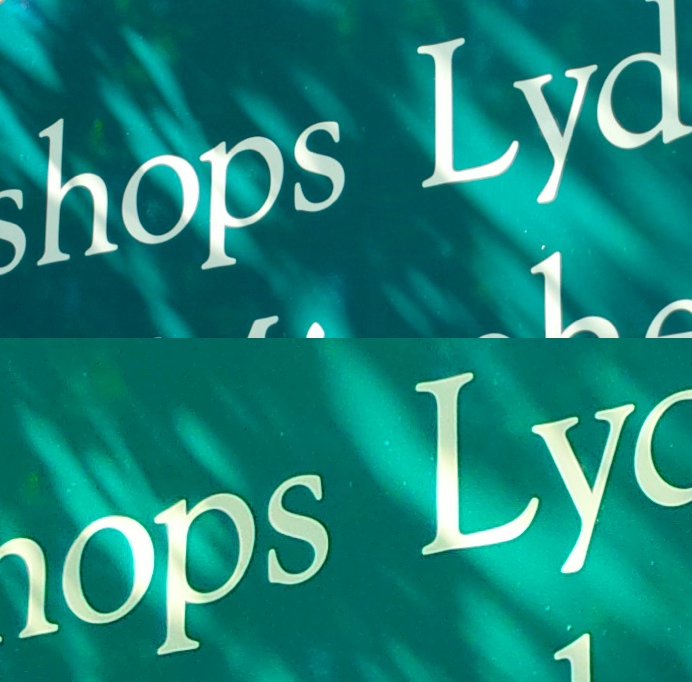
The Galaxy S4 Zoom's image is gloriously crisp and detailed, but the green of the sign is a tiny bit too light, the letters show slight signs of edge enhancement, and so on. In contrast, the Nokia 808's photo remains gloriously rich in terms of both colour and detail. A clear win for the Nokia 808's oversampling, though I'd also say that the photo from the S4 Zoom is still very good - I'm being very picky here.
Here's the second unzoomed scene, this church lit by dazzling sun, but as seen through a corridor of shadow. Again tricky for any camera phone to get right:

The original photos are here: Nokia 808 PureView, Samsung Galaxy S4 Zoom
And here's a slight crop of the centre detail from each image, Nokia 808 on top, Samsung Galaxy S4 Zoom below:
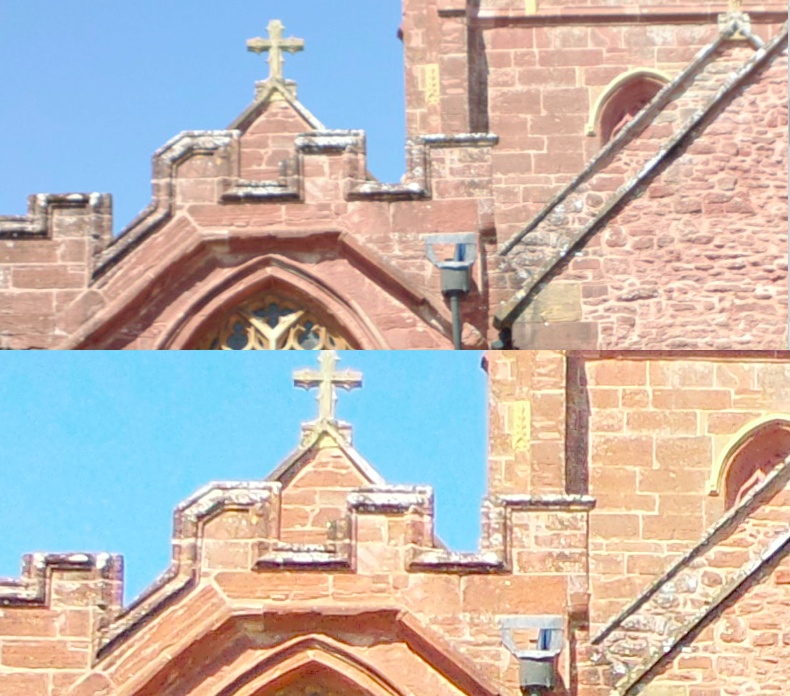
Again, the PureView oversampling does an amazing job, with noiseless sky and with stonework that looks... real. The S4 Zoom's image is typical of modern Samsung smartphone cameras here, with slightly blown out colours in the intense light, oversharpened edges and a somewhat 'artificial' feel to the photo.
Having said that, again, both photos, viewed at screen resolution on a desktop or TV, look absolutely fine.
Finally, a night scene, with the last of the day's light fading away and very little illumination on the centre focussed subjects (the vehicles):

The original photos are here: Nokia 808 PureView, Samsung Galaxy S4 Zoom
And here's a slight crop of the centre detail from each image, Nokia 808 on top, Samsung Galaxy S4 Zoom below:
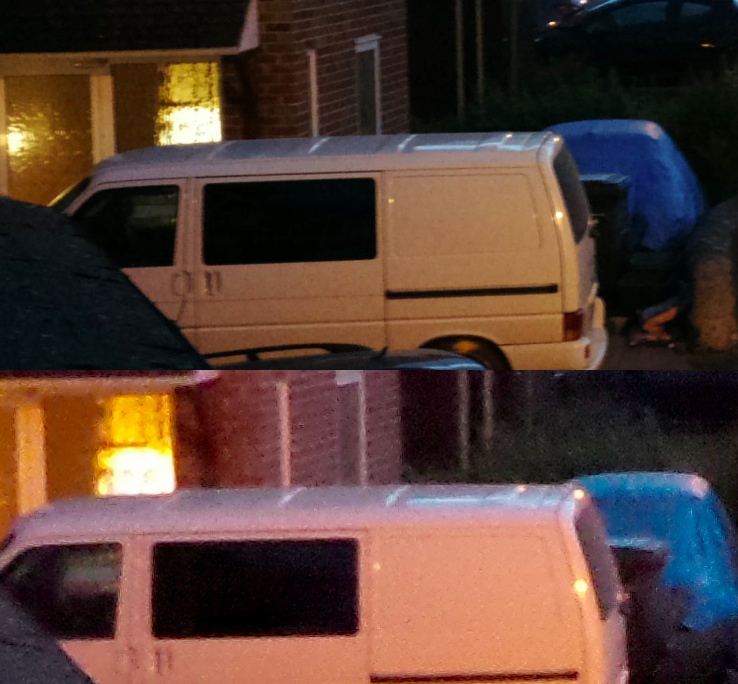
Yet again the PureView system eliminates digital noise and produces very classy results. In contrast, the S4 Zoom's smaller sensor, and with the optical zoom lenses meaning that less light was let in, produced results which are 'fuzzy' at best - the artefacts on every detail are very apparent.
Now, it would have been very easy for me to do ten such test photos and proclaim the 808 the runaway winner. Yet Nokia do publicise the 'zoom' advantages of its PureView system and I maintain that I was right to concentrate the bulk of my comparisons in shots which used a degree of zoom as well, in light of the specific abilities of the new challenger.
Having used the S4 Zoom as my main camera (and phone) for a week and a half now, I'm torn. With the optical zoom (plus OIS), it's so easy now to get candid shots of people, with that 'close up' look you only really see from DSLRs and in magazines. The creative possibilities of having the 'real' zoom are terrific, here's the moon, as shot by me on the S4 Zoom, handheld. If you're not impressed by this at least then I give up(!):
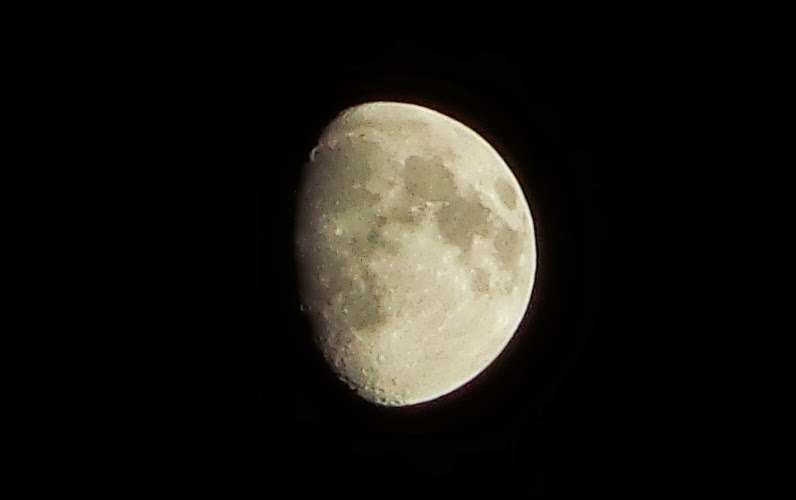
On the other hand, the S4 Zoom is bulky and awkward, even by 808 standards, plus its photos are never as 'pure' as those from the 808. At least it's an easy tradeoff to understand, and you can absorb my conclusions on photo quality here and make your own mind up.
Video capture
As with photos, there's a lot of settings that can be adjusted for video on both devices, but as a quick comparison here's some footage, shown back to back, in full sunlight (of noisy subject), then indoors, in the quiet, and finally outdoors again but using 3x zoom to get closer to my subject.
A tough call here, honours even? I prefer the Galaxy S4 Zoom's colours on balance, but the 808's oversampled quality comes good a few times and there's the superior audio capture. The 'zoom' argument isn't so valid here, since even the Nokia 808 can achieve 6x video zoom (in 720p mode), so that 10x optical zoom isn't quite as much a leap forward in most light conditions. I suppose in low light with maximum zoom needed, the S4 Zoom would stride ahead, but then we really are talking niche use cases.
As we found many moons ago using the old Nokia N93 and N93i, zooming during video capture on the Galaxy S4 Zoom results in some pick up of motor noise (a slight clicking), even with 'quiet zoom enabled' (effectively software cancellation of the motor noise). It's not a showstopper compared to typical ambient noise from whatever you're filming (unless it's a silent landscape!), but it's definitely there and notable compared to the truly silent PureView zoom on the Nokia 808.
In real world use
With the Nokia 808, getting to the camera is incredibly quick - just press and hold the shutter key while you're taking the phone out of your pocket or case and the viewfinder will be active before you're lined up, ready for action. Rather curiously, the S4 Zoom's camera can't (currently) be launched from its huge shutter button. Or even from the action ring on the back. Instead, you currently have to unlock the screen first (so a button press and a swipe) before then tapping the Camera icon or long pressing the shutter button. Or you can turn on lock screen app shortcuts and then swipe up from the Camera icon there, which is faster. But surely, surely this is an oversight in the first S4 Zoom firmware - expect a long press of the shutter button to work through the lock screen shortly. After all, that's how just about every other device with a physical shutter button works!
Both device displays are pretty good outdoors - the Nokia 808's Clear Black Display polarisers give it a slight edge, but (unlike many cheaper devices with cheaper displays) I had no issues taking photos with either, even in full sunlight. The screen sizes are similar too (the 808's is a smidgen smaller), so it's hard to pick an overall winner in this department.
When getting really creative, with a tripod, the S4 Zoom scores heavily with its integral tripod mount. Just remove the plug with your finger nail (and yes, this will probably get lost) and screw in as needed. In contrast, the Nokia 808 PureView has to be clamped in something like Nokia's rather flawed HH-23 accessory, itself screwed to a tripod.
Both devices are, thankfully, easy enough to hold to shoot photos one handed, if needed. Obviously, you'd go for a two handed hold if possible, for safety, but at a pinch the contours of both the 808 and S4 Zoom mean you can fire off snaps just holding the device in your right hand. Something I wouldn't really recommend with thinner devices.
Some people have asked about battery life of the S4 Zoom - it's roughly on a level with other top Android devices, in that it'll get you through a day, but no further. The extra data use involved with Android, plus the needs of the big camera and its motors, see to it that you'll not find much left in the morning if you forgot to put it on charge at bedtime. In contrast, I still maintain that I get two days from each Nokia 808 charge, though I'll freely admit that there are several functions (Google+, web browsing, games) which I find myself using quite a bit more on the Android phone, partly explaining the reduced life on a charge.
In terms of software, the Nokia 808 PureView really, really needs users to invest in something like Gravity, handling all image sharing from within the all consuming social client, since Facebook and Twitter sharing on Symbian currently requires the use of Nokia Social. Functional but hardly elegant or speedy. In contrast, on Android, it's wonderfully refreshing to be able to share to any installed application or service directly from the main Gallery application, with no compromises or speed penalties.
Finally, I was asked about durability and robustness. I'd have to favour the Nokia 808's almost solid state design here - those telescopic zoom parts on the Samsung and their motors are definitely a long term worry, and especially so if the device gets dropped. But I'm not going to put either of these phones to the test here, obviously(!)
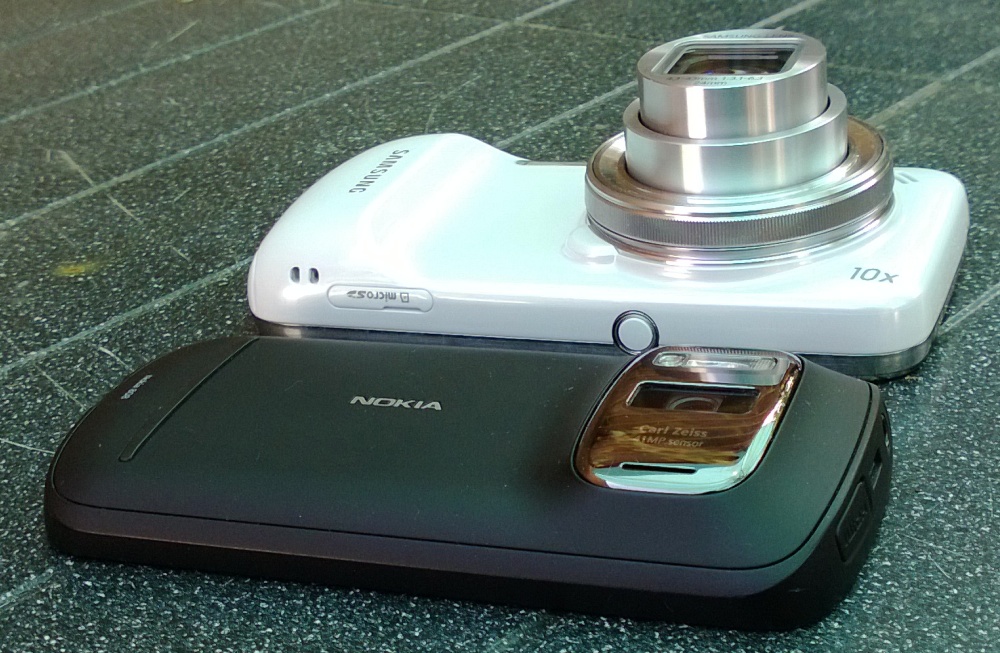
The verdict
The question is, of course, would I trade in my Nokia 808 PureView for the Samsung Galaxy S4 Zoom? And would I be tempted to pass over both for the upcoming Nokia Lumia 1020, with (in theory) the best bits of the 808, but with added OIS?
Before answering, I'm tempted to say that the question is somewhat moot because a) all three take fabulous photos across a wide range of conditions, and b) all three run totally different operating systems, existing in totally different ecosystems. In short, pick your ecosystem or favourite interface and there'll be a camera phone champion to match.
However, this is chickening out slighty. The Samsung Galaxy S4 Zoom is a beast of a device. The Android side is certainly up to par, while the presence of a full 10x optical zoom plus OIS means that you can get photos from it, candidly, as and when needed, that wouldn't otherwise be possible on any other smartphone. Even the Nokia PureView devices.
The caveat is the form factor and complexity, though. The contrast with the comparatively svelte form of the Nokia 808 PureView (go on, how many times has that adjective been applied to the Nokia 808 before?!?), with its integral camera hump and sweeping curves, couldn't be more dramatic. The Nokia 808 has been everywhere with me for a year and not once have I questioned its existence on the ground of size. Not once. In contrast, every single time I pull the S4 Zoom from my pocket or bulky belt case I'm reminded that it's effectively a smartphone in the body of a camera and I ask myself for the umpteenth time 'Do I really want to carry this all the time?'
A tough call overall though. Despite the dramatic zoom capabilities of the Samsung Galaxy S4 Zoom, leaving aside the questions of OS and ecosystem, I'm going to side with the 808 and go with the more sensible, pocket friendly form factor and the unbelievably pure photos it produces for most subjects.
However, with Symbian's continuing slow demise, and with my objective 'real world' hat on, I'd suggest that anyone who had been eyeing up a move to Android anyway might well find the S4 Zoom to be the device that most closely replicates the 808's camera abilities on the world's current dominant smartphone platform. And to hell with the form factor.
Or there's the Lumia 1020 and another new adventure, perhaps with Windows Phone 8 GDR2? Or even Sony's rumoured new 20MP imaging powerhouse, due for announcement in the next few weeks? Or Motorola's 'clear pixel' Moto X, also due for revealing? There's certainly no shortage of options.
The Nokia 808 may have won this battle - just, but there's a multi-party, full scale war about to break out on all fronts in the world of smartphone imaging.
No hay comentarios:
Publicar un comentario